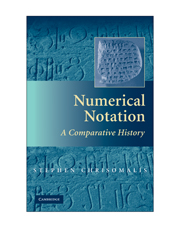Book contents
- Frontmatter
- Contents
- Acknowledgments
- 1 Introduction
- 2 Hieroglyphic Systems
- 3 Levantine Systems
- 4 Italic Systems
- 5 Alphabetic Systems
- 6 South Asian Systems
- 7 Mesopotamian Systems
- 8 East Asian Systems
- 9 Mesoamerican Systems
- 10 Miscellaneous Systems
- 11 Cognitive and Structural Analysis
- 12 Social and Historical Analysis
- 13 Conclusion
- Glossary
- Bibliography
- Index
4 - Italic Systems
Published online by Cambridge University Press: 18 May 2010
- Frontmatter
- Contents
- Acknowledgments
- 1 Introduction
- 2 Hieroglyphic Systems
- 3 Levantine Systems
- 4 Italic Systems
- 5 Alphabetic Systems
- 6 South Asian Systems
- 7 Mesopotamian Systems
- 8 East Asian Systems
- 9 Mesoamerican Systems
- 10 Miscellaneous Systems
- 11 Cognitive and Structural Analysis
- 12 Social and Historical Analysis
- 13 Conclusion
- Glossary
- Bibliography
- Index
Summary
The Roman numerals are undoubtedly one of the better-known numerical notation systems, and have received a tremendous amount of scholarly attention. Nevertheless, they constitute only a part of a larger phylogeny of numerical notation systems that originated, not among Romans, but among Etruscans and Greeks on the Italian peninsula around 600–500 bc. The name “Italic” refers only to this geographical origin, and thus does not reflect any shared linguistic or cultural affiliation. Italic systems flourished between 500 bc and 500 ad throughout the Mediterranean region, Western Europe, and North Africa, under conditions of Greek and Roman cultural hegemony and political domination. Ironically enough, however, the collapse of the Roman Empire brought about the greatest expansion of one particular system - the Roman numerals - in medieval Europe, and ultimately throughout the modern Western world. The most common variants of the Italic numeral-signs are shown in Table 4.1.
ETRUSCAN
The Etruscans were a non-Indo-European people whose civilization had its center in north central Italy, in the region of modern Tuscany (whose name is taken from the Latin Tusci, meaning Etruscan). The origins and civilization of the Etruscans are poorly understood, and large parts of their language remain undeciphered. Yet Etruscan civilization was the most potent political force on the Italian peninsula between around 800 and 300 bc, and significantly influenced Roman culture throughout the Republic and even later. The Etruscan alphabet, developed in the early seventh century bc on the model of the archaic Euboean Greek alphabet, usually runs from right to left (Bonfante 1996).
Information
- Type
- Chapter
- Information
- Numerical NotationA Comparative History, pp. 93 - 132Publisher: Cambridge University PressPrint publication year: 2010
